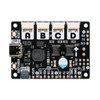

A compact 4 channel motor+encoder controller, powered by RP2040. It has RGB and per-motor indicator LEDs plus built in voltage and current sensing.
Motor 2040 is a standalone motor controller for driving motors with encoders attached. Encoder motors can provide feedback to the controller, enabling more precise control over position and velocity - perfect for building a four wheel drive robot rover or buggy.
Why limit yourself to vehicular constructs though, you could use it as the brains of any project that involves motors: elaborate pulley systems, 1:12 replicas of It's A Small World or even customisable dials with haptic feedback and programmable endpoints.
Motor 2040 comes with many useful built-in bells and whistles, such as:
- An addressable RGB LED (AKA Neopixel) for visual feedback and status reports.
- A pair of mono indicator LEDs on each motor channel to show you when and in what direction a motor is moving. This helps visualise what your code is doing and means you can prototype without having motors plugged in!
- A QW/ST connector to make it easy to attach Qwiic or STEMMA QT breakouts - great for adding some sensor smarts.
- Some neat voltage/current/fault sensing features to help prevent motor mishaps.
It's supported by a well documented C++/MicroPython motor and encoder library with lots of examples to show you how to use the individual features (and everything together).
Features
- Powered by RP2040 (Dual Arm Cortex M0+ running at up to 133Mhz with 264kB of SRAM)
- 2MB of QSPI flash supporting XiP
- 2 Dual H-Bridge motor drivers (DRV8833)
- 4 JST-SH connectors (6 pin) for attaching motors
- Wide voltage range for motors and logic (2.7V to 10V)
- On-board 3V3 regulator with input up to 13.2V (max regulator current output 150mA)
- Onboard voltage, current and fault sensing
- Per motor current limiting (0.5A) *
- Per motor direction indicator LEDs **
- Addressable RGB LED/Neopixel
- Reset and BOOT button (the BOOT button can also be used as a user button)
- USB-C connector for programming and power (3A max)
- Qw/ST (Qwiic/STEMMA QT) connector for breakouts
- Fully-assembled
- C++/MicroPython libraries
- Schematic
- Dimensional drawing
Software
Because it's a RP2040 board, Motor 2040 is firmware agnostic! You can program it with C/C++, MicroPython or CircuitPython.
Pimoroni's C++/MicroPython libraries will help you get the most out of Motor 2040, they're packed with powerful features for working with motors. You'll get best performance using C++, but if you're a beginner we'd recommend using our batteries included MicroPython build for ease of getting started.
You can also use CircuitPython on your Motor 2040, if you want access to all the nice conveniences of Adafruit's ecosystem.
- Download CircuitPython for Motor 2040 (coming soon)
- Getting Started with CircuitPython
- CircuitPython examples
Powering Motor 2040
Motor 2040 can be powered either by plugging the board into a USB-C power source (like a PC or power bank) or by connecting a battery pack to the EXT PWR or VSYS connections. On an unmodified board, you should only have one power source connected at a time, to avoid back-powering your computer or battery.
If you want to have two power sources connected at the same time, Motor 2040 has two traces on its underside that you can cut to do this safely.
- Cut EXT PWR to VSYS if you want to provide your motors with a separate power supply (up to 10V) from that used to power the rest of the board. Board power (up to 13.2V) will need to be provided either by USB 5V or VSYS.
- Cut USB 5V to VSYS if you want to run the board entirely off a separate power supply, without worry of back-powering your computer. Note that this also means the board will not turn on when only connected by USB.
Below is a simplified circuit diagram showing the power wiring:

Notes
- Measurements: 52mm x 38mm x 7.7mm (L x W x H). The mounting holes are M2.5 and 2.7mm in from each edge.
- * The current limit of each motor can be disabled by soldering the "high current" pads on the rear (doing this will also disable the current monitoring). The maximum supported output current when unlimited is 1.2 A continuous (2 A peak) per motor.
- ** The direction indicators for each motor can be disabled by cutting the "motor LED" traces on the rear.
- The pinout of the JST-SH motor connectors is M+, M-, 3v3, A, B, GND.
- Motor 2040 has some extra broken out headers that adventurous roboticists might find useful (note that these are unpopulated and so will require soldering):
- 2 sets of headers for connecting analog sensors
- 1 set of headers for connecting a serial device, or an 3.3V ultrasonic distance sensor
- Unpopulated screw terminals for supplying external power (10A max continuous current)
- Exposed analog, Breakout Garden and debug pins





